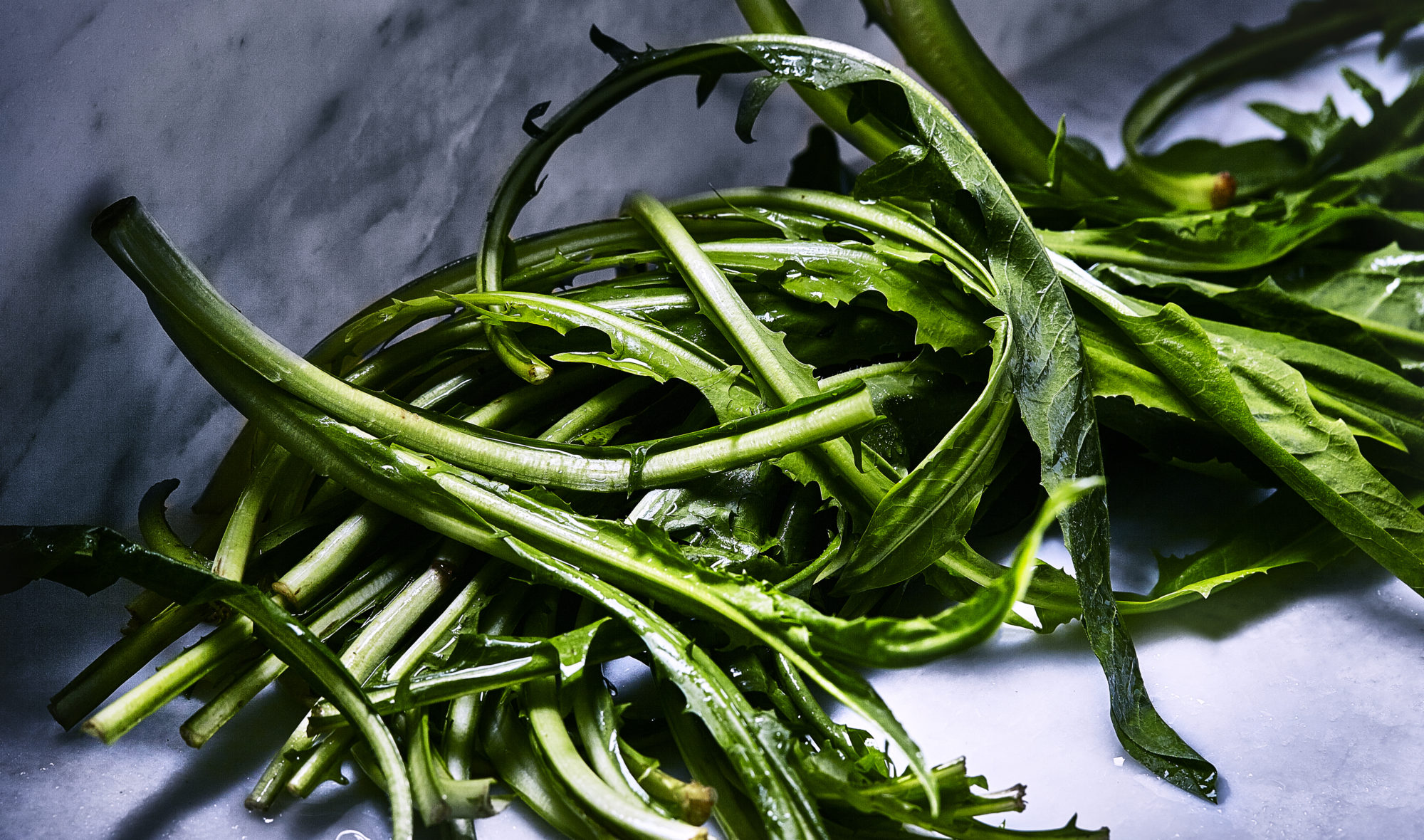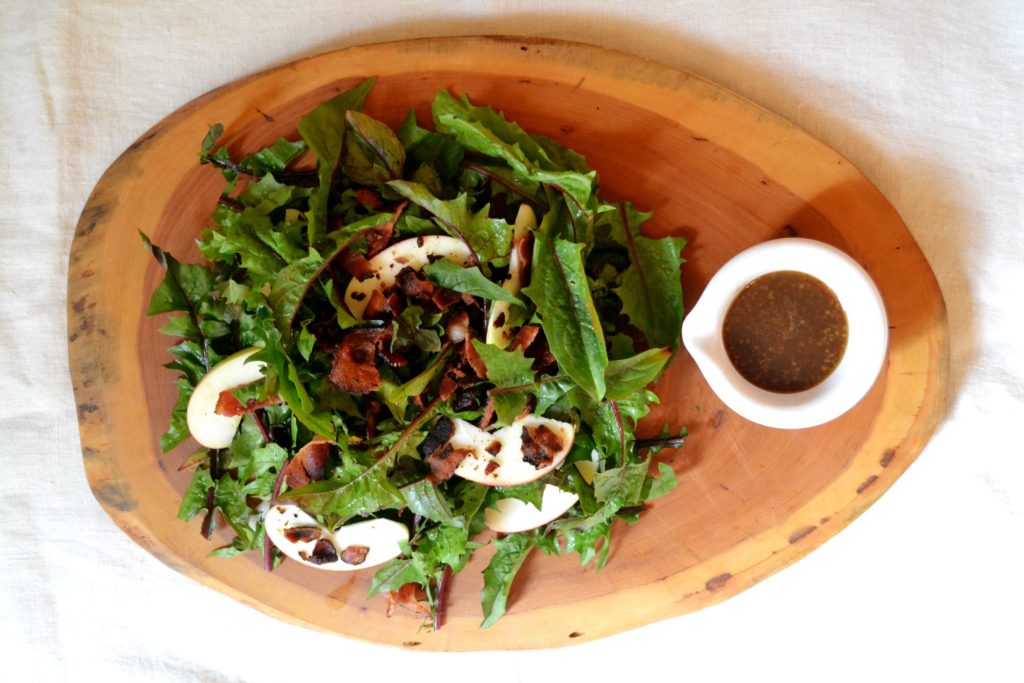
🎁 Holiday Special: SAVE 52% on the Nutrition Coach Starter Package. Limited number remaining.

🎁 Holiday Special: SAVE 52% on the Nutrition Coach Starter Package. Limited # left.

Not just a garden thug choking out more delicate flora, dandelions are a food too. Although most of the dandelions that grow under our feet are likely unfit for consumption due to their exposure to dirty sneakers, doggie business, and garden chemicals, dandelions may be the most abundantly growing food item in many urban and wild landscapes. If you know a clean source from which to harvest greens, or if you find a grocery store that carries them, you will discover a plant with an unconventional green bitterness that can add complexity and interest to a dish if prepared in the right way. Dandelion greens are also extremely nutritious, being a rich source of vitamin A, folate, vitamin K, vitamin C, calcium, and potassium. If you are ready to have a culinary adventure, try some dandelions. If you are an urban forager, just be sure to wash them well. Very well.
Dandelions. Sure, they are garden thugs. They will crowd out lawns and gardens with their sunny heads and deeply toothed leaves. They will choke out your begonias and mob your green grass. Upon maturity, they will transform their blossoms into a globe of fluffy, parachuting seed-minions that, with the encouragement of the gentlest breeze, will travel far and wide in order to implant themselves to ensure the continuation of their species. They will resist plucking, stomping, and chemical warfare.
But you can also eat them.
Those very same weeds that have been endlessly trampled over, peed on by dogs, and otherwise ripped out of the ground and flung into the air with distaste, can also be put into your mouth. (Well, maybe not the very same ones. Maybe find a clean patch for your edible harvest.)
Dandelion leaves (which are generally the only parts used for food) are not commonly seen at most dinner tables. However, among health-conscious and creative cooks, the sharply bitter leaves may find their way into salads and sautés.
In addition to the leaves, dandelion flower petals can be turned into dandelion wine, and dandelion root can be dried and roasted and used to make a dark, rich, bitter brew, similar to coffee.
Dandelions, both leaves and root, are also used in herbal medicine. One of dandelion’s primary medicinal functions is to act as a diuretic. The plant, particularly the root, also stimulates liver function.
It is likely that nearly everyone has stomped on a dandelion plant. You will recall the tiny radiating yellow petals that form the bushy head, the milky stalk, and the deeply indented green leaves.
The leaves, which are generally green but also come in red or purple tinged varieties, have borders that look remarkably like a row of lion’s teeth. The name dandelion in fact comes from this resemblance, and is named after the French term for lion’s tooth, “dent de lion”.
The leaves, especially when harvested young, are soft but also quite fibrous. The flavor of dandelion greens is bitter – a rich, earthy bitterness that can be shocking to some palates.
Culinary tip: Adding just the right amount of fat, acid, and sweet to your dandelion dish can offset this cheek pinching bitterness.
One cup of chopped, raw dandelion greens (about 55g) has 25 calories, 1.5g protein, 0.4g of fat, 5.1g of carbohydrates, 1.9g fiber, and 0.4g sugar. Dandelion greens are an excellent source of vitamin A, folate, vitamin K, and vitamin C (in its raw form), and a good source of calcium and potassium.
Although dandelions grow abundantly across urban and wild landscapes alike, please don’t eat them indiscriminately. You never know what has been sprayed on them, whether from chemical or animal origin.
The best place to get fresh dandelion greens is from farmers’ markets when in season, or from larger, more progressive grocery stores (dandelion greens being a rarity at most smaller grocery stores).
Dandelion greens typically come in gathered bunches. The leaves should look glossy and firm – no discoloration or wilting. Generally speaking, smaller leaves will be less bitter, so keep size in mind too.
Dandelion greens can be kept in a plastic bag in the crisper drawer of the fridge, and don’t wash them until you’re ready to eat them, as washing beforehand will promote wilting. Stored this way, they will last two or three days.
Dandelion greens can also be blanched and frozen for six months to a year.
Dandelion greens are not difficult to prepare, although their extremely bitter flavor requires a bit of culinary creativity to work with.
To eat, trim the very ends of the stems off then wash the leaves well by immersing them in a bowl of cool water and swishing them around to loosen any grit. You may have to dump and replace the water a few times until the wash water runs clear. Once cleaned, cut your dandelion greens in desired shapes and then follow one or more of the following techniques to manage the bitterness:
Dilution: One way to reduce the bitterness of dandelions is to simply dilute them with other foods. For example, cut dandelion leaves into small pieces and toss with a variety of other milder tasting greens to make a salad base.
Distraction: Another way to compliment dandelions is to use other strong flavors to mask or distract from the strong taste of this plant. For example, adding sufficient fat, acids like vinegar or lemon juice, and / or careful amounts of sweetness from chopped apple or sweeter dressings will all help to deceive the taste buds.
Leaching: When dandelion greens are boiled in water, some of the bitter constituents are leached out into the water, resulting in a milder tasting green. Boiling for three to five minutes should be sufficient to both reduce bitterness and fully cook the greens.

Health meets indulgence in this salad! Fresh, bitter dandelion greens are complimented perfectly with the savory richness of bacon, and the sweetness of maple and apple.
Prep Time: 10 minutes Cook Time: 10 minutes Yield: 1-2 servings
For the Salad
First, chop the very ends of the stems off (this is the bitterest part of the plant), and then wash your greens thoroughly. Pat them dry with a clean kitchen towel or run them through a salad spinner. Chop them coarsely, and then set them aside in a large bowl.
Next, prepare your apple, and add it to the bowl.
Finally, cook your bacon in a pan over medium-high heat until brown and crispy. When the bacon is done, remove the strips and lay them on a paper towel to cool. Once they have cooled, chop them up into desired shapes, and add to the bowl.
For the Dressing:
Add all ingredients to a jar and whisk vigorously with a fork until combined. Pour entire contents over your salad and then toss. Eat immediately.
Serves one as a meal, or two as a side dish. Enjoy!
Precision Nutrition’s Encyclopedia of Food expands every single month as we highlight new foods and showcase beautiful food photography. If you’d like to stay up to date, simply click this link. From there, we’ll send you a FREE copy of our recipe book. We’ll also let you know when new and delicious foods are added to the site.
Not just a garden thug choking out more delicate flora, dandelions are a food too. Although most of the dandelions that grow under our feet are likely unfit for consumption due to their exposure to dirty sneakers, doggie business, and garden chemicals, dandelions may be the most abundantly growing food item in many urban and wild landscapes. If you know a clean source from which to harvest greens, or if you find a grocery store that carries them, you will discover a plant with an unconventional green bitterness that can add complexity and interest to a dish if prepared in the right way. Dandelion greens are also extremely nutritious, being a rich source of vitamin A, folate, vitamin K, vitamin C, calcium, and potassium. If you are ready to have a culinary adventure, try some dandelions. If you are an urban forager, just be sure to wash them well. Very well.